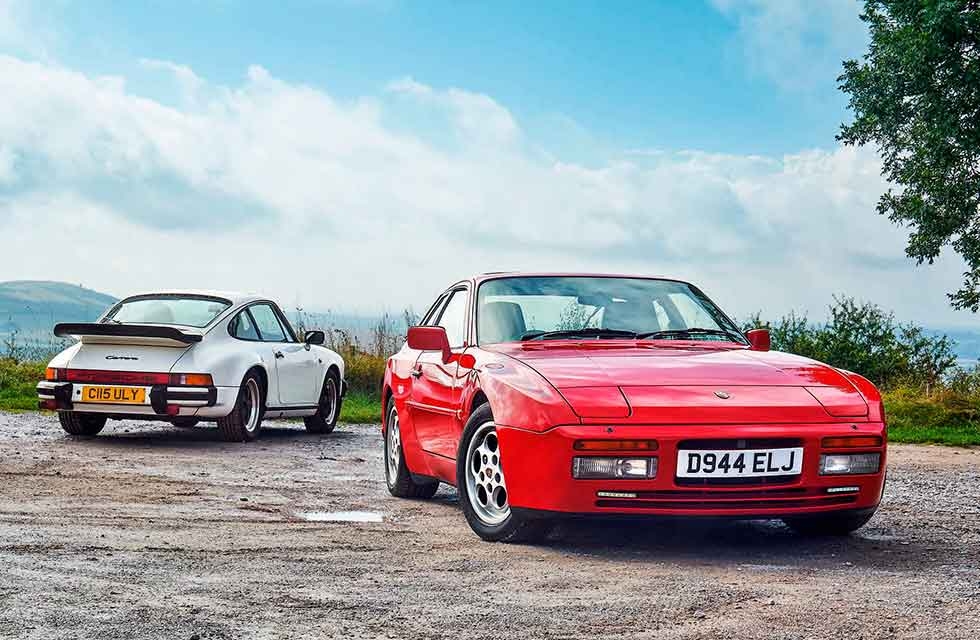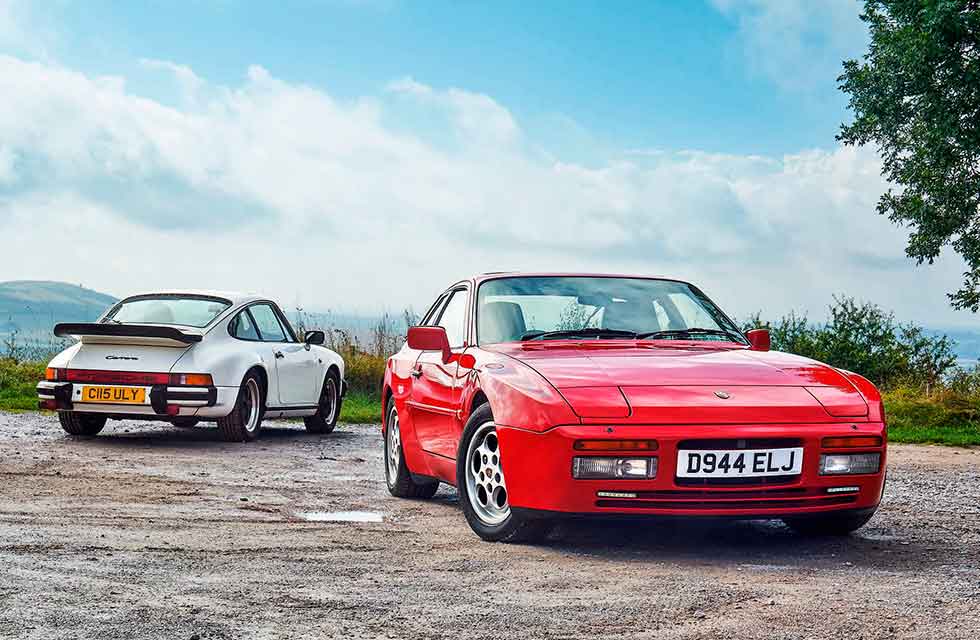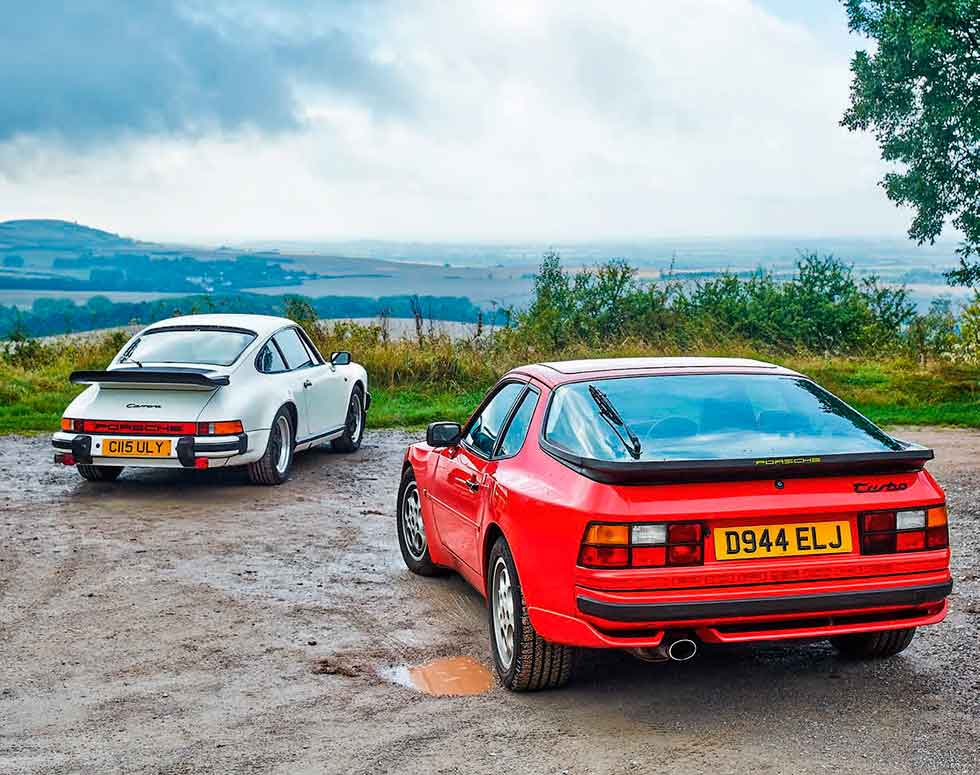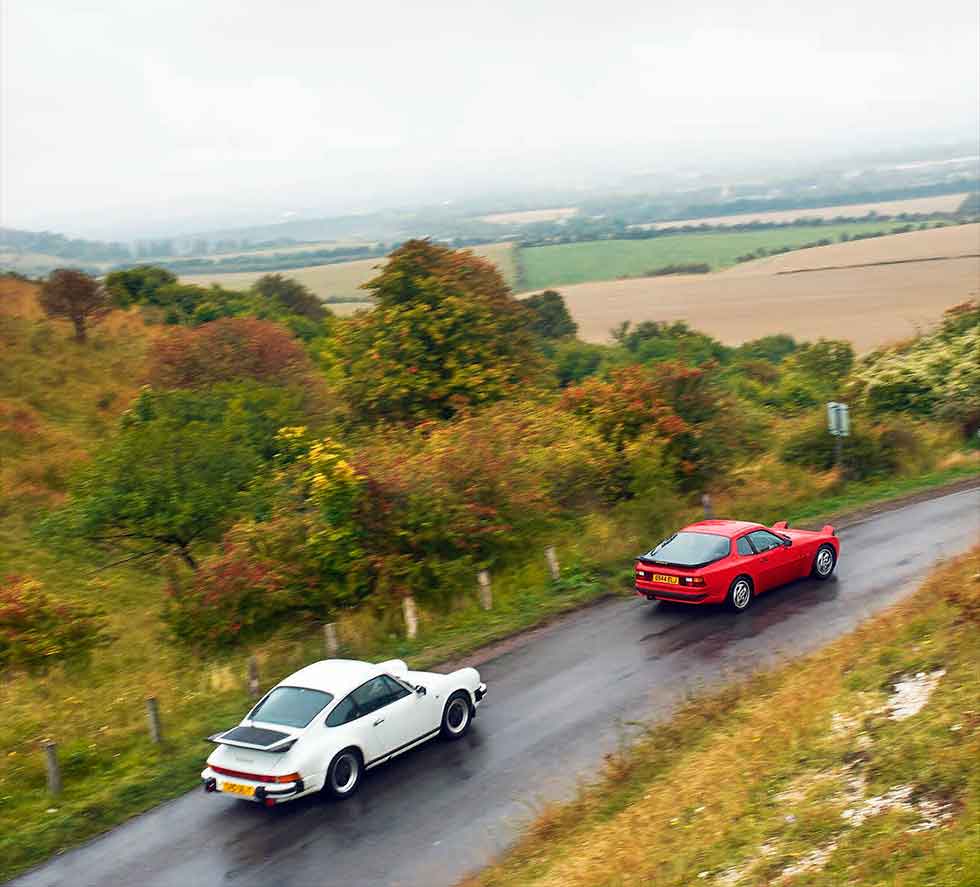
In 1986 the 944 Turbo and 3.2 Carrera were closely matched on paper and on the road, but how do they stack up 28 years later? Story: Adam Towler. Photography: Gus Gregory.
33 years later
’80s ICONS GO HEAD-TO-HEAD Porsche 944 Turbo vs 3.2 Carrera
When they were new the 944 Turbo and 3.2 Carrera were identically priced and offered similar performance, but nearly 30 years later are the siblings the rivals they once were?

It’s 1986, and in Porsche showrooms across the country a battle is simmering away. Since its launch in 1982 the 944 has successfully filled the role of the junior Porsche, striking a chord in the market through its box arch muscular presence and at last, a ‘proper’ Porsche engine derived from half of the 928’s V8.
The 944 was part of an eminently rational three-car range under 1970s boss Ernst Fuhrmann, but by the mid-’80s the outlook was rather different. The Porsche 924 had struggled to gain traction as an entry-level Porsche, suffering from a similar kind of market resistance that befell its predecessor, the VW-Porsche 914. At the top end, Fuhrmann’s masterpiece, the enigmatic Porsche 928, was clearly never going to be the 911 replacement it was designed to be, and settled into the role of the niche grand tourer.

Even when one car seemingly has an advantage, the other finds a way to strike back
Most of all, it was personalities that had shifted the picture. It’s not fair to say that Fuhrmann disliked the 911 – he was happy to fund its extensive competition career, after all – but he was only prepared to keep the run-out 911, the SC, alive as long as customers still bought it.
He believed that situation would terminate around 1981. The trouble for Fuhrmann was that Porsche’s customers did indeed continue to buy the SC, starved as it was of any major development budget. Moreover, it became a pawn in an increasingly bitter battle between Fuhrmann and the Porsche family. By late 1980, Fuhrmann was gone, and a new CEO sat in the chair. His name was Peter Schutz.

Schutz had a very different approach, and realised that the 911 lay at the heart of the brand’s appeal – and was also a key profit centre. He immediately reassigned development budget to the car.
That led to the 3.2 Carrera for the 1984 model year, the car we have with us today. Although visibly very similar to the SC, the new Carrera chiefly benefited from an enlarged flat- six, taken out to 3164cc (over the SC’s 3.0-litre unit) thanks to the use of the Turbo’s 74.4mm stroke crankshaft. This 930/20 engine features a higher compression ratio of 10.3:1 thanks in part to new forged pistons, but the really key news was the adoption of the Bosch Motronic 2 (DME) engine management system alongside LE-Jetronic fuel injection, which contributed to a 10 per cent reduction in fuel economy as well as a new power output of 231hp at 5900rpm and 209lb ft of torque peaking at 4800rpm.
Pressurised timing chain tensioners finally solved that particular Achilles heel, while the braking system was upgraded at the same time. A pair of foglamps integrated into the front air dam is one visual difference, and if so equipped, a slightly restyled whale tail wing adopting a flat vented top similar to the Turbo ‘tea tray’ but without the turned-up sides. Clearly, the cash was spent on the engine: aerodynamic improvements would arrive via a much bigger project already in its infancy, the 964.
The 3.2 Carrera was the right car at the right time. The 911 suddenly became the 911 to own, keenly received by press and customers alike. In the United Kingdom, after the 1986 ‘Big Bang’ deregulation of the financial markets, a Guards red Carrera was the defacto choice for a generation of City Boys spending money nearly as quickly as they were making it.
What, then, of this aforementioned showroom battle? What was this new internal enemy, probing at the Carrera’s notable weaknesses, exposing areas where the old stager really did show its age? The protagonist was the 944 Turbo, appearing in 1985.
Given the handling proficiency of the regular 944, it was inevitable that the car would receive more power. It just begged for it. The 944 was a brilliant basis for a high performance variant, thanks to the perfect 50:50 weight distribution of its front-mid engine, transaxle layout.
One of the biggest challenges was making a 200hp+ turbocharged four-cylinder car reliable, so to that end a special KKK K26 turbo was designed with a water-cooled central bearing housing that reduced temperatures after the engine shut down via a small electric pump. The block was strengthened, with forged pistons and a completely redeveloped cylinder head also included. Much thought was put into packaging, with the turbo mounted on the induction side of the engine and an air/air intercooler slipped into the nose. Like the Carrera, the Turbo adopted Bosch’s Motronic system, but on a more advanced level with full knock control and an electronically controlled wastegate. The car was also designed to work from the outset with a catalytic converter, thereby making it one of Porsche’s first ‘global’ engines.
The result was 220hp at 5800rpm and a very purposeful 243lb ft of torque at 3500rpm, but there was more to the Turbo than just its engine: the whole car was substantially upgraded in time-served Porsche fashion. It featured a stronger clutch and gearbox, larger Brembo braking system, stiffer anti-roll bars and spring/damper units, and the debut of the second-generation dashboard and interior that was to roll out across the 944 range. From the outside, the Turbo was unmistakeable: a beautifully integrated and much more aggressive nose section; sill extensions, and a new rear bumper, with the car riding on Teledial alloys.
In 1986, it must have looked very appealing indeed. And that was just as well, because Porsche’s new front-engined charger went on sale in the UK for £25,312, just £10 less than a new Carrera. Soon the Turbo’s price had risen by £2235; incidentally, by 1987 it was £34,168, albeit including ABS, and by 1988 it was £36,000. The 250hp 944 Turbo S of that same year cost £41,250…
Original 220hp turbocharged engine was less laggy than the later 250hp and was easier to drive than its 911 contemporary
A Carrera required the Sport Package to bring it up to the specification of the Grand Prix white car here, consisting of front air dam, whale tail rear wing, Bilstein shocks and 16-inch Fuchs forged alloys. Price-wise there was nothing between them.
They were also incredibly close on performance. Both are six seconds to sixty and 150mph-plus cars, with mere tenths here and there separating them. Even when one car seemingly has an advantage, the other finds a way to strike back: the Turbo is significantly heavier at 1350kg to the Carrera’s 1160kg, but 243lb ft versus 209lb ft is no contest even before you look at what peaks those figures are realised at. What seems obvious is that the 911 driver will need to change gear a lot to stay in touch, but then as we will discover, gear choice can be vital in the Turbo as well, though for different reasons.
I drive the Carrera first. Of course, driving any air-cooled 911 is always an event in itself, and a 3.2 Carrera is certainly no different. I should know C115 ULY rather well as it’s mine. Having said that, I’ve only had it for a couple of months and to be honest, we’re still in the getting-to-know-each- other phase. That’s the thing with an old 911, they take time to learn, whether it be getting the best out of them on the road or understanding the blunderbuss approach to interior ergonomics.
They also make demands on the driver. You have to really drive a Carrera in a way that must have become a bind if you were only going to flit between the Stock Exchange and a wine bar in 1986. The much-maligned 915 gearbox is fine if set up well – ULY’s could use a little adjustment to be fair – but isn’t the easiest of shifts to make perfect, while the steering is unremittingly heavy at slow speeds. There is plenty of engine noise in the cabin at all times, which must have made hearing anything on your brick-sized mobile phone impossible, and for those not inclined to read an operating manual, the ventilation system is perplexing to say the least. In short, if the only reason you were buying this car was for the badge on the nose and the wing on its tail, I suspect it might have felt a little bit too much like hard work when you took delivery in the spring of 1986 – not that any City Boy would ever have admitted that.
You would, naturally, have already stocked up on magazine reviews and (more) wine bar hearsay about the Carrera’s penchant for dumping you tail first into the nearest hedge you could find. Of course, the Carrera is much more liable to understeer off into the nearest hedge… I jest, but the Carrera’s grip is actually superb (especially on modern rubber), traction is predictably immense, and when the level of grip is exceeded it simply tends to run wide at the front. However, it will oversteer at some point of course, but particularly if one lifts off the throttle in a corner when the car is under significant cornering force. And just as obviously, with all the weight in the tail, when momentum does take hold, it can be hard to resist. It’s this misreported chassis drama that gave the Carrera a ‘can you tame the dark side’ appeal that wasn’t irrelevant in the showroom.
For now, my task is to keep ULY firmly in the slipstream of the Turbo. Once the red coupé’s blower is puffing it takes off, visibly squatting on its rear suspension and squirting forwards with a punch the Carrera struggles to contain. In the 911, and despite the longer stroke of the revised flat-six, you really need 3500rpm on the dial before it pulls hard, and the meat of the performance is delivered over 4500rpm, accompanied by an urgent howl. Keeping it on the boil is the challenge, and then having the confidence to trust it in the corners is the next hurdle to be overcome. Driven hard it’ll stay with the 944, but the gap between them is like a piece of elastic, growing and contracting as the road throws up different challenges along our route.
The 911 was given a stay of execution under Peter Schutz. The 3.2 Carrera was the result of the first serious investment for many years.
But the 911 is such an invigorating experience. By the end of our run I am completely captivated by keeping the 911 pointing in the right direction at speed. The sound and smell of the car consumes my senses, and all I can think about is the car, the way it bobs and pitches around, stops hard; the way it feels alive.
The 944 Turbo is the absolute opposite. This particular example is just about standard, and incredibly has over 200,000 miles on the clock. Owner Frank had a R32 Nissan Skyline GTR before it, so he’s used to big boost machines, and he’s been amazed by the Turbo’s malleable character: “The Porsche says ‘any driver I’ll give a fun time to, whether that’s just to the shops or to burn up the tyres’. I reckon anyone could drive this car and be happy. It took me a long time to really understand it, it’s hard to suss it out because it has no vices, but I can relax in this car like no other. It’s a car that looks out for you.” But he’s clear on the car’s ultimate performance, too: “There was a time when I wondered if it really had anything for me, but then I took it on a track day (laughs) and realised it was me that didn’t have the beans for it!”
Frank is right. If the Carrera is the ’80s wide boy flaunting its big wing and oozing machismo, then the Turbo is a mild-mannered Kraftwerk reject, hiding at the back of the room, getting ahead through the use of technology in a fast-changing world. I’ve always thought these cars were the ultimate in Teutonic rational thinking. It’s a feeling you get from them the moment you drop into the seat and start the big four-cylinder engine. There’s no romance to them: it’s all about cold, hard effectiveness, beautifully delivered.
And oh boy is the Turbo effective. I’ve had the good fortune to drive a few 250hp Turbos over the years, but never before an original 220hp, and it feels like a subtly but nevertheless importantly different car.
There’s less lag than with the bigger turbo in the later car, and the suspension setup and grip from the smaller tyres is softer and milder. It’s a less aggressive machine than a 250hp, but that also makes it a more pleasant car at times, and it certainly comes on the boil quicker.
Just as the Carrera needs a good stoking to come alive, so does the 944, but it’s all about whether the turbo is spinning or not. Without it, it’s not just subdued like a low-revving Carrera, it’s positively non-existent in terms of forward motion. Once 3500rpm arrives the Turbo really does kick forward, maintaining that boost all the way to the upper reaches of the rev range, and overlaying the gruff four-cylinder note with plenty of turbo whistle. As such, your whole gear selection strategy revolves around making sure the turbo is spinning: every corner, every twisting section of road needs to be viewed as an exercise in being on boost.
Its ace card, however, is that famous chassis balance. This car is incredibly benign, and never intimidating. The easy power steering is lovely, pointing the car exactly where you intend it to go without any second inputs. Corners are strung together in flowing arcs, the ride is more settled than the Carrera, naturally, and very quickly it’s a car you feel you can do just about anything with. When the weather is bad, it’s the 944 that inspires much more confidence.
Of course, history tells us the 911 won this particular dust up, even if sales went into decline of the later G50 gearbox variant as the recession really bit hard. It was the 911 that has lived on through various incarnations to the present day, not the 944-idea, and the former also now commands values many times that of the Turbo.
The real irony of this comparison is that many of those non-enthusiast Carrera buyers in 1986 would have been much better off with the 944 Turbo. It’s so much easier to drive, its personality more adaptable, and it’s almost absurdly tolerant of mistakes and general ham-fistedness for a 150mph car. In many ways it’s the perfect sports coupé for every occasion.
And yet… I think this is a classic case of moth-to- a-flame mentality. We don’t buy cars like these because they’re the best practical solution. I know that if I had walked into a Porsche Centre in 1986 and seen these two for the same price I couldn’t have resisted the 911. Just one look at the Carrera today and my palms itch, and I begin to salivate. I know it has its foibles but just to be in its company for a few minutes is to feel the drama.
The 944 Turbo is a brilliant car, and personally, I’d really like to own one – more than ever having driven this nice 220hp-spec example. It’s a landmark car in many respects, even outside the Porsche world. But I don’t like the Carrera, I love the Carrera, and I suppose that’s at the heart of the difference.
SPECIFICATION 944 TURBO
Engine: Four-cylinders in-line, turbocharger
Max power: 220hp @ 5800rpm
Peak Torque: 243lb ft @ 3500rpm
HP-per-litre: 88.7hp/L
Weight: 1350kg
Gearbox: Five-speed transaxle
Suspension: Independents wishbones, McPherson struts, coil springs, hydraulic dampers, anti-roll bar (front); torsion bars, hydraulic dampers, anti-roll bar (rear)
Brakes: Ventilated discs, four-piston callipers
Top speed: 152mph
0-62mph (1988): 6.3 seconds
Cost new: £25,312 (1986 UK)
911 3.2 CARRERA
Engine: Six-cylinders, horizontally opposed
Max power: 231hp @ 5900rpm
Peak Torque: 209lb ft @ 4800rpm
HP-per-litre: 73hp/L
Weight: 1160kg
Gearbox: Five-speed
Suspension: Independent wishbones, McPherson struts, gas, dampers, anti-roll bar (front); Semitrailing arms, torsion bars, gas, dampers, anti-roll bar (rear)
Brakes: Ventilated discs, two-piston callipers
Top speed: 152mph
0-62mph (1988): 6.1 seconds
Cost new: £25,322 (1986 UK)
Many thanks to Frank for the loan of his 944 Turbo for this feature. The car is currently for sale, for any enquiries call 07501 883881. Thanks also to RPM Technik for their assistance (www.rpmtechnick.co.uk)






